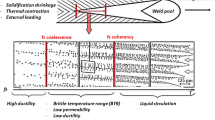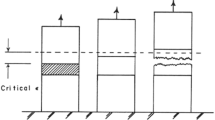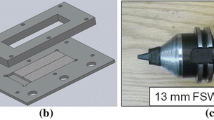Abstract
Solidification cracking is a weld defect common to certain susceptible alloys rendering many of them unweldable. It forms and grows continuously behind a moving weld pool within the two-phase mushy zone and involves a complex interaction between thermal, metallurgical, and mechanical factors. Research has demonstrated the ability to minimize solidification cracking occurrence by using appropriate welding parameters. Despite decade’s long efforts to investigate weld solidification cracking, there remains a lack of understanding regarding the particular effect of travel speed. While the use of the fastest welding speed is usually recommended, this rule has not always been confirmed on site. Varying welding speed has many consequences both on stress cells surrounding the weld pool, grain structure, and mushy zone extent. Experimental data and models are compiled to highlight the importance of welding speed on solidification cracking. This review is partitioned into three parts: part I focuses on the effects of welding speed on weld metal characteristics, part II reviews the data of the literature to discuss the importance of selecting properly the metrics, and part III details the different methods to model the effect of welding speed on solidification cracking occurrence.












Similar content being viewed by others
Abbreviations
- h :
-
Plate thickness
- s :
-
Travel speed
- t :
-
Time
- x :
-
Direction of heat source displacement
- BTR:
-
Brittle temperature range
- CRW:
-
Controlled restraint weldability test
- CSA:
-
Cross-sectional area
- CSZ:
-
Crack susceptible zone
- EBW:
-
Electron-beam welding
- G :
-
Temperature gradient
- GTAW:
-
Gas tungsten arc welding
- I :
-
Welding current
- LBW:
-
Laser beam welding
- LHC:
-
Linear heat content
- MVT:
-
Modified varestraint transvarestraint test
- P :
-
Welding power
- PVR:
-
Program VerformungRisstest
- R :
-
Solidification growth rate
- SCTR:
-
Solidification cracking temperature range
- T :
-
Temperature
- TVT:
-
Transvarestraint test
- U :
-
Welding voltage
- ε :
-
Strain
- \( \dot{\varepsilon} \) :
-
Strain rate
- η :
-
Welding efficiency
References
Nguyen TC, Weckman DC, Johnson DA, Kerr HW (2006) High speed fusion weld bead defects. Sci Technol Weld Join 11:618–633. https://doi.org/10.1179/174329306X128464
Nguyen TC, Weckman DC, Johnson DA, Kerr HW (2005) The humping phenomenon during high speed gas metal arc welding. Sci Technol Weld Join 10:447–459. https://doi.org/10.1179/174329305X44134
Pickens JR (1985) The weldability of lithium-containing aluminium alloys. J Mater Sci 20:4247–4258. https://doi.org/10.1049/ep.1966.0223
Campbell J (2003) Castings. Elsevier Science Ltd
Nelson TW, Lippold JC, Lin W, Baeslack WA (1997) Evaluation of the circular patch test for assessing weld solidification cracking, part I–development of a test method. Weld J 76(3):110–119
Matsuda A, Nakagawa H, Nakata K, Okada H (1979) The VDR cracking test for solidification crack susceptibility on weld metals and its application to aluminum alloys. Trans JWRI 8:85–95
Chihoski RA (1972) The character of stress fields around a weld arc moving on aluminum sheet. Weld J 168:9s–18s
Hunziker O, Dye D, Roberts SM, Reed RC (2001) A coupled approach for the prediction of solidification cracking during the welding of superalloys. In: Cerjak H (ed) Mathematical modelling of weld phenomena 5, pp 299–319. IOM Communications 2001
Shibahara M, Serizawa H, Murakawa H (2005) Finite element method for hot cracking analysis using temperature dependent interface element. In: Hot Crack. Phenom. Welds. Springer, pp 253–257
Cicalǎ E, Duffet G, Andrzejewski H, Grevey D, Ignat S (2005) Hot cracking in Al-Mg-Si alloy laser welding - operating parameters and their effects. Mater Sci Eng A 395:1–9. https://doi.org/10.1016/j.msea.2004.11.026
Dudas JH, Collins FR (1966) Preventing weld cracks in high-strength aluminum alloys. Weld J 45:241s–249s
Dowd JD (1952) Weld cracking of aluminum alloys. Weld J 31:448s–456s
Jennings PH, Pumphrey WT, Soltðus ATIE (1948) A consideration of the constitution of aluminium-iron-silicon alloys and its relation to cracking above the solidus. JIM. 44:249–258
Jennings PH, Singer ARE, Pumphrey WT (1948) Hot shortness of some high-purity alloys in the systems aluminium-copper-silicon and aluminium-magnesium-silicon. JIM. 74:227–248
Mossman MM, Lippold JC (2002) Weldability testing of dissimilar combinations of 5000- and 6000-series aluminum alloys. Weld J:188–194
Mousavi MG, Cross CE, Grong O (2009) The effect of high-temperature eutectic-forming impurities on aluminum 7108 weldability. Weld J 88:104–110 http://0.0.2.53
Mousavi MG, Cross CE, Grong Ø, Hval M (1997) Controlling weld metal dilution for optimised weld performance in aluminium. Sci Technol Weld Join 2:275–278. https://doi.org/10.1179/stw.1997.2.6.275
Coniglio N, Cross CE, Michael T, Lammers M (2008) Defining a critical weld dilution to avoid solidification cracking in aluminum. Weld J 87:237s–247s
Cross CE, Coniglio N, Westin EM, Gumenyuk A (2011) Laser weldability of stainless steel. In: Hot Crack. Phenom. Welds III. Springer, pp 131–144. https://doi.org/10.1007/978-3-642-16864-2-8
Nelson DE, Baeslack-III WA, Lippold JC (1987) An investigation of weld hot cracking in duplex stainless steels. Weld J 66:241s–250s
Cieslak MJ, Ritter AM, Savage WF (1982) Solidification cracking and analytical electron microscope of austenite stainless steel weld metals. Weld J 61:1s–8s
Nishimoto K, Mori H (2004) Hot cracking susceptibility in laser weld metal of high nitrogen stainless steels. Sci Technol Adv Mater 5:231–240. https://doi.org/10.1016/j.stam.2003.10.006
Lundin CD, Chou CPD (1983) Hot cracking susceptibility of austenitic stainless steel weld metals. Weld Res Counc 289:1–79 http://www.aws.org/wj/supplement/WJ_1982_03_s82.pdf
Ankara A, Ari HB (1996) Determination of hot crack susceptibility in various kinds of steels. Mater Des 17:261–265. https://doi.org/10.1038/447149a
Senda T, Matsuda T, Takano F, Watanabe G, Kobayashi K, Matsuzaka T (1971) Fundamental investigations on solidification crack susceptibility for weld metals with trans-varestraint test. Trans JWS 2:1–22. https://doi.org/10.2207/qjjws1943.41.709
Statharas D, Atkinson H, Thornton ROB (2019) Getting the strain under control : trans-varestraint tests for hot cracking susceptibility. Metall Mater Trans A 50:1748–1762. https://doi.org/10.1007/s11661-019-05140-0
Slyvinsky A, Herold H, Streitenberger M (2003) Influence of welding speed on the hot cracking resistance of the nickel-base alloy NiCr25FeAlY during TIG-welding. In: Crack. Phenom. Mech., pp 42–58
Arata Y, Matsuda F, Nakata K, Shinozaki K (1977) Solidification crack susceptibility of aluminum alloy weld metals (report III). Trans JWRI 6:47–52
Coniglio N, Cross CE (2009) Mechanisms for solidification crack initiation and growth in aluminum welding. Metall Mater Trans A 40:2718–2728. https://doi.org/10.1007/s11661-009-9964-4
Fabrègue D, Deschamps A, Suéry M, Proudhon H (2008) Hot tearing during laser butt welding of 6xxx aluminium alloys: process optimisation and 2D/3D characterisation of hot tears. In Hot Cracking Phenomena in Welds II, pp 241–255. Springer, Berlin, Heidelberg
Coniglio N, Cross CE, Michael T, Lammers M (2008) Defining a critical weld dilution to avoid solidification cracking in aluminum. Weld J (Miami, Fla) 87(8):237s-243s
Coniglio N, Cross CE (2008) Weld parameter and minor element effects on solidification crack initiation in aluminium. In: Hot Cracking Phenomena in Welds II, pp 277–310. Springer, Berlin, Heidelberg
Argawa G, Gao H, Armithalingam M, Hermans M (2018) Study of solidification cracking susceptibility during laser welding in an advanced high strength automotive steel. Metals (Basel) 8:1–15. https://doi.org/10.3390/met8090673
Ploshikhin V, Prikhodovsky A, Makfiurin M, Iiin A (2005) Integrated mechanical-metallurgical approach to modeling of solidification cracking in welds. In: Hot Crack. Phenom. Welds. Springer, Berlin, Heidelberg, pp 223–244
Goodwin GM (1987) Development of a new hot-cracking test - the Sigmajig. Weld J (Miami Fla):33s–38s
Goodwin GM (1988) The effects of heat input and weld process on hot cracking in stainless steel. Weld J 67(4):88s–94s
Johnson BYL (1973) Formation of plastic strains during welding of aluminum alloys. Weld J 52:298s–305s
Ohshita S, Yurioka N, Mori N, Kimura T (1983) Prevention of solidification cracking in very low carbon steel welds. Weld J 283:129s–136s
Feng Z, Zacharia T, David S (1996) On the thermomechanical conditions for weld metal solidification cracking. In: Cerjak H, Bhadeshia HKDH (eds) Math. Model. Weld Phenom. 3, pp 114–148. The Institute of Materials
Niel A, Deschaux-beaume F, Bordreuil C, Fras G, Drezet J-M (2011) Hot tearing test for TIG welding of aluminum alloys: application of a stress parallel to the fusion zone. In: Hot Crack. Phenom. Welds III, pp 43–58. https://doi.org/10.1007/b139103
Coniglio N, Patry M (2013) Measuring laser weldability of aluminium alloys using controlled restraint weldability test. Sci Technol Weld Join 18:573–580. https://doi.org/10.1179/1362171813Y.0000000137
Hagenlocher C, Weller D, Weber R, Graf T (2018) Reduction of the hot cracking susceptibility of laser beam welds in AlMgSi alloys by increasing the number of grain boundaries. Sci Technol Weld Join:1–7. https://doi.org/10.1080/13621718.2018.1534775
Morgan-Warren EJ, Jordan MF (1976) Effect of travel speed on solidification cracking in autogenous tungsten inert gas arc welding of low- alloy steel sheet. Met Technol:29–40. https://doi.org/10.1179/030716976803391421
Arata Y, Matsuda F, Nakata K, Katayama S (1977) Solidification crack susceptibility in weld metals of fully austenitic steels (report II) – effect of ferrite, P, S, C, Si, and Mn on ductility properties of solidification brittleness. Trans JWRI 6:105–117
Davies GJ, Garland JG (1975) Solidification structures and properties of fusion welds. Int Metall Rev 20:83–108
Borland JC (1961) Suggested explanation of hot cracking in mild and low alloy steel welds. Br Weld J:526–540
Borland JC (1960) Generalized theory of supersolidus cracking in welds (and castings). Br Weld J:508–512
David SA, White CL (1986) Formation of hot cracks in austenitic stainless steel welds — solidification cracking. Weld Res Suppl 209-s:203–212
Sterjovski Z, Bayley C, Donato J, Lane N, Lang D (2014) Weld-end solidification cracking in pulsed-tandem gas metal arc welding of naval steels. Weld J 93:145s–152s
Holt M, Olson DL, Cross CE (1992) Interfacial tension driven fluid flow model for hot cracking. Scr Metall Mater 26:1119–1124
Hosseini SA, Abdollah-zadeh A, Naffakh-Moosavy H, Mehri A (2019) Elimination of hot cracking in the electron beam welding of AA2024-T351 by controlling the welding speed and heat input. J Manuf Process 46:147–158. https://doi.org/10.1016/j.jmapro.2019.09.003
Konadu DS, Pistorius PGH, Du Toit M, Griesche A (2019) Solidification cracking susceptibility of ferritic stainless steels using modified Varestraint Transvarestraint (MVT) method. Sadhana - Acad Proc Eng Sci 44:13–15. https://doi.org/10.1007/s12046-019-1175-0
Rappaz M, Drezet JM, Gremaud M (1999) A new hottearing criterion. Metall Mater Trans A 30(2):449–455
Coniglio N, Mathieu A, Aubreton O, Stolz C (2014) Plasma effect on weld pool surface reconstruction by shape-from- polarization analysis. Appl Phys Lett 104:131603. https://doi.org/10.1063/1.4870505
Bakir N, Pavlov V, Zavjalov S, Volvenko S, Gumenyuk A, Rethmeier M (2019) Development of a novel optical measurement technique to investigate the hot cracking susceptibility during laser beam welding. Welding in the World 63(2):435–441
Matsuda F, Nakagawa H, Tomita S (1986) Quantitative evaluation of solidification brittleness of weld metal during solidificaiton by in-situ observation and measurement (report III). Trans JWRI:125–133
Rajani HRZ, Phillion AB (2018) 3D multi-scale multi-physics modelling of hot cracking in welding. Mater Des 144:45–54. https://doi.org/10.1016/j.matdes.2018.02.007
Zacharia T (1994) Dynamic stresses in weld metal hot cracking. Welding Journal Including Welding Research Supplement 73(7):164–172
Cross CE, Bollinghaus T (2006) The effect of restraint on weld solidification cracking in aluminum. Weld World 50:51–54
Robino CV, Reece M, Knorovsky GA, DuPont JN, Feng Z (2006) Prediction of maximum crack length in longitudinal varestraint testing. In: Trends in welding research: Proceedings of the 7th International Conference, pp 313–318
Richards NL, Nakkalil R, Chaturvedi MC (1994) The influence of electron-beam welding parameters on heat-affected-zone microfissuring in INCOLOY 903. Met Mat Trans A 25:1733–1745
Sandstrom R (1992) Harmonisation of weldability data for aluminum alloys. In: 5th International Conference in Aluminum. Weldments, Munich, pp 5.3.1–5.3.14
Soysal T, Kou S (2018) A simple test for assessing solidification cracking susceptibility and checking validity of susceptibility prediction. Acta Mater 143:181–197. https://doi.org/10.1016/j.actamat.2017.09.065
Matsuda F, Nakata K, Harada S (1980) Moving characteristics of weld edges during solidification in relation to solidification cracking in GTA weld of aluminum alloy thin sheet. Trans JWRI 9:83–93
Matsuda F, Nakagawa H, Kohmoto H, Honda Y, Matsubara Y (1983) Quantitative evaluation of solidifïcation brittleness of weld metal during solidification by in-situ observation and measurement (report II). Trans JWRI:73–80
Kannengiesser T, McInerney T, Florian W, Bollinghaus T, Cross CE (2002) The influence of local weld deformation on hot cracking susceptibility. In: Cerjak H, Bhadeshia HKDH (eds) Mathematical modelling of weld phenomena 6. Maney, pp 803–817
Coniglio N, Cross CE (2016) Towards establishment of weldability testing standards for solidification cracking. In: Cracking phenomena in welds IV. Springer, Cham, pp 37–66
Author information
Authors and Affiliations
Corresponding author
Additional information
Publisher’s note
Springer Nature remains neutral with regard to jurisdictional claims in published maps and institutional affiliations.
Rights and permissions
About this article
Cite this article
Coniglio, N., Cross, C.E. Effect of weld travel speed on solidification cracking behavior. Part 2: testing conditions and metrics. Int J Adv Manuf Technol 107, 5025–5038 (2020). https://doi.org/10.1007/s00170-020-05232-x
Published:
Issue Date:
DOI: https://doi.org/10.1007/s00170-020-05232-x




